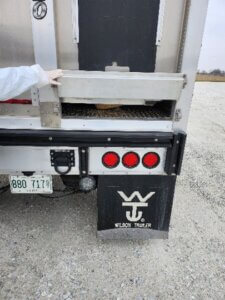
Project #: SHIC 23-018 | Principal Investigator: Dustin Boler, Bailey Harsh | Institution: Carthage Innovative Swine Solutions, University of Illinois | Posted: 11/14/2023 | Keywords: Truck wash biosecurity, ATP bioluminescence, disease monitoring, surveillance
This research evaluated the performance of two adenosine triphosphate (ATP) instruments to estimate cleanliness in livestock trailers. The results of the ATP instruments were compared to aerobic plate counts (bacterial contamination) to determine if ATP bioluminescence could be used as an indicator of trailer cleanliness without the need for visual inspection. ATP is a source of cellular energy that is present among all living organisms. This includes viruses and bacteria that remain after a commercial trailer cleaning. Normally, trailer cleanliness is determined visual evaluation by a person that inspects the trailer to determine if it is free of organic material and suitable to return to a farm. However, studies have demonstrated that visual inspection of cleaned transport trailers may be insufficient to ensure cleanliness and reduce disease transmission risk because viruses and bacteria are microscopic in nature and cannot be seen by the human eye. Further, visual inspection to determine if a trailer is clean usually occurs after the invested cost of propane to dry the truck has occurred. ATP bioluminescence uses a chemical reaction where a swab is used to detect the presence of ATP. The more ATP that is present, the greater the chemical reaction. This technology uses the same chemical process a firefly uses to illuminate. When ATP is exposed to the enzyme a light is produced. The more ATP that is present the brighter the light. The intensity (brightness of the light) is measured in relative light units (RLU). A greater RLU indicates more ATP and reduction in overall cleanliness. So, this technology can be equated to the brightness of a firefly. The brighter a firefly glows; the more ATP is present. In this case, the brighter the swab glows, the more ATP is present, the more potential microbial contamination is present. The goals of this project were to determine the areas of the trailer with the greatest surface contamination, the correlation between microbial counts and RLUs, and the number of locations that need to accurately determine surface cleanliness.
This project evaluated livestock trailers at two commercial trailer washes. One of those locations included trailers that were known to transport livestock from a farm known to be PRRS or PEDv positive. In total, 100 livestock trailers were tested usings biolumiomters to determine the amount of ATP that remained after a commercial trailer wash. Protocols are in place to prevent people from entering a livestock trailer after it has been cleaned to prevent contamination. For this technology to be adopted into practice, locations inside the trailer that are accessible from outside the trailer must be evaluated. This trial evaluated the back door flush gate (BDFG), rear drivers side access door (RSAD), the belly flush gate (BFG), belly side access door (BSAD), nose side access door (NAD).
 Figure 1 Back door flush gate. An area of the trailer that is indicative of overall trailer cleanliness.
Figure 1 Back door flush gate. An area of the trailer that is indicative of overall trailer cleanliness.
The results from this study indicated that the areas of highest concern sampled in this study were the nose access door and the back door flush gate as detected both by ATP bioluminescence and APC. A key finding of this research was that nose access door was the area least likely to be adequately cleaned, but only a few trailers actually had nose access doors. Nearly all of the trailers evaluated had a back door flush gate and therefore makes it a logical place to swab a livestock trailer to determine the overall cleanliness.
The ability of ATP to be used as an indicator of trailer cleanliness was dependent on the instrument used, with the 3M machine being more closely correlated with bacterial contamination. Swabs were also collected to determine the presence of PEDv, but all swabs were negative. These data suggest that ATP bioluminometers can be used in livestock trailers to quickly determine the general cleanliness of the trailer without the need for a visual inspection. Bacterial swabs to determine APC levels should also be used to determine the effectiveness of the cleaning protocol.
Copyright 2024 | Swinehealth.org | Website by Heartland Marketing Group